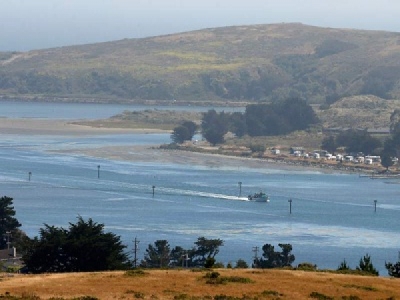
Posted on July 11, 2017
By Mary Callahan, The Press Democrat
Safe harbor has been a relative term of late for many of the hundreds of boats that tie up in Bodega Bay to seek refuge from pounding North Coast swells.
Navigation channels used by boats to enter and leave the small port — one of the few available to ocean-going fishermen and pleasure boats north of the Golden Gate — have gradually accumulated wave-washed sediment and runoff over the years. Storms this winter added more mud and debris to the mix as a massive plume of sediment spread south from the mouth of the rain-swollen Russian River.
As a result, deep-hulled craft, including many fishing and sailboats, have been forced to travel in and out of the harbor at high tide to avoid running aground, scrambling regular traffic patterns and threatening access critical for distressed or disabled vessels, according to maritime veterans and officials. Coast Guard operations at the Bodega Bay base also have been hampered.
“It affects everybody,” said seasoned local fisherman Dick Ogg.
Sonoma County officials announced this week that some relief is in on the way for the harbor, where the Army Corps of Engineers now plans to carry out an overdue dredging project this fall. The work, slated to cost about $4.4 million, will remove an estimated 110,000 cubic yards of excess sediment — enough to fill roughly 8,000 dump trucks — that has settled into the harbor since 2004, when the channels were last dredged.
It also will curtail buildup of sediment in side channels, improving access to marinas, wharves and the U.S. Coast Guard Station Bodega Bay, said Peter Mull, project manager for the Army Corps.
The agency is legally responsible for maintaining the harbor’s navigation channel at a depth of 12 feet when the ocean is at the mean level of the lowest low tide of the day.
“But they, quite simply, don’t have enough money to meet that obligation, and they have obligations all around the country,” said Sonoma County Supervisor Lynda Hopkins. “And quite frankly, smaller harbors like Bodega Bay have taken a back seat to other harbors, because they’re in triage mode.”
She and other county officials credited the lobbying efforts of recently retired Sonoma County Regional Parks Director Caryl Hart, as well as North Coast Rep. Jared Huffman and Mike Thompson with securing the funds for Bodega Harbor. Hart was in Washington at least three times to advocate for the funding priority. Hopkins visited the nation’s capital to speak on its behalf, as well.
“We were very lucky to get this money,” said Hopkins, who represents Bodega Bay, where the local commercial fishing fleet and much of the region’s recreational boating are centered.
Competition for limited federal funds is stiff, and the Army Corps already is two years behind its targeted 11-year cycle for channel maintenance in Bodega Harbor. Dredged five times since 1961, the last project was in 2004.
Since then, the sea and runoff from shore have washed silt, soil and sand into the channel and caused shoaling that makes for ridges and high spots at various points along the way. Heavy rains last winter also likely contributed to the problem, Hopkins and other officials said.
“At extreme low tide, you don’t even see the channel,” Spud Point Marina Superintendent Noah Wagner said. “It’s just mud flat to mud flat.”
Local boat captains can point to spots where the water is 10 feet deep or less at low tide, limiting navigable areas for larger, deeper-drafting boats — especially those weighed down with gear and live bait, or coming back in with a hold full of fish.
Non-local crews unfamiliar with the harbor face additional peril, especially in the dark or in heavy fog. Many sailboats also have deep keels that can ground if the skipper isn’t careful, Wagner said.
Stan Davis, whose family owns a 72-foot fishing boat called Nightwind, said he has to enter and leave the harbor at high tide, even if it’s at night. Moreover, intake pumps that help circulate 80,000 gallons of water through the hold, sustaining live crabs or live bait, can easily suck up mud from the harbor floor and smother living fish in the hold.
Additionally, channel restrictions force deeper-hulled boats toward the eastern edge of the navigation channel, interfering with maritime traditions that have vessels pass each other on the starboard, or right side of the boat and putting skippers at risk of crashing.
“You’ll have these sport boats coming in,” Wagner said. “He’s zooming at you, waiting for you to move over, but not realizing you’re restricted to one side.”
The material scooped up from the harbor bottom will be loaded onto scows and deposited at a deep-sea site about 55 miles west of the Golden Gate Bridge or a shallower site about 3 miles from shore. The work is carefully regulated to ensure that spoils are transferred along an approved route and do not affect the protected Farallon Islands and Greater Farallones National Marine Sanctuary, Superintendent Maria Brown said.
Deputy Regional Parks Director Jim Nantell said the difficulties faced by Coast Guard personnel launching rescues and bringing in disabled vessels were key in bringing attention and funding to Bodega Bay.
“If we didn’t have the Coast Guard station there, we probably wouldn’t have gotten it addressed at this point in time,” he said.
Source: The Press Democrat





